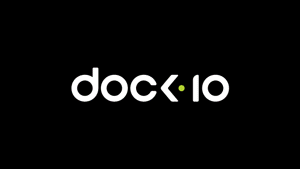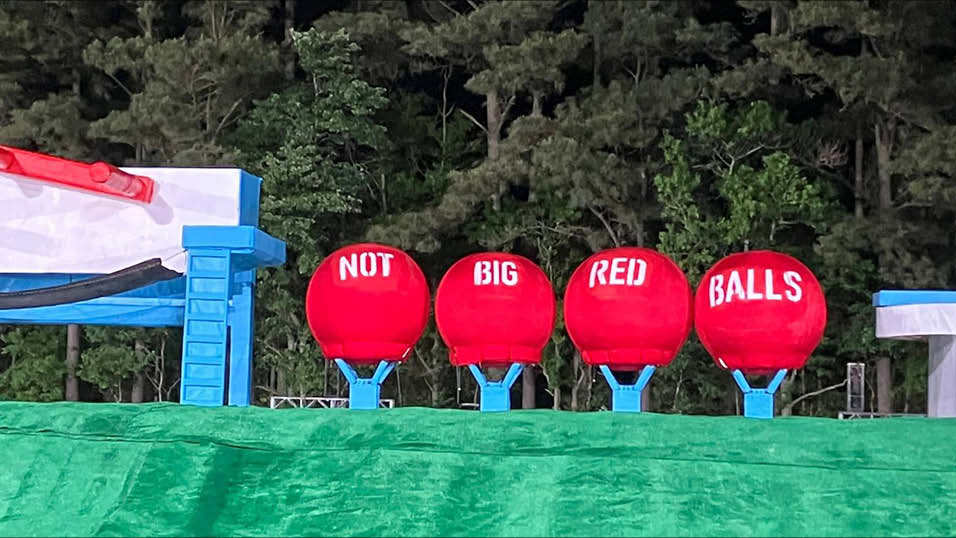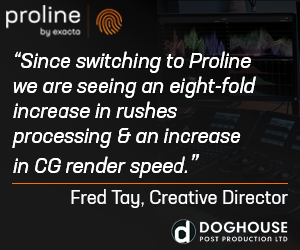You don’t have to be a particularly devoted follower of production technology to have been bombarded by talk of all things 4K of late. Here’s why you should care…
It seems everybody is going on about 4K at the moment – but what exactly is it? Well, the basics are straightforward enough – it’s an image with a resolution of 4,096 x 2,160, which equates to 8.8 million pixels. This is over four times the 2 million pixels of 1,920 x 1,080 HD resolution.
This is, of course, just numbers, and means nothing if it doesn’t translate to a much better looking image on screen. Fortunately, it does – 4K is a much more immersive experience than stereoscopic 3D and, while 4K acquisition makes perfect sense for a huge cinema screen display, the difference in clarity of image is also hugely noticeable on a more modest size 4K TV screen.

Consumer TV sets
Back to some numbers again. Consumer 4K (or, rather, Ultra HD) TV sets have a resolution of 3,840 x 2,160, which is slightly lower than the image size captured by 4K cameras and equates to around 8.3 million pixels. This reduction in resolution makes very little difference to the overall impact of the image.
At IBC last year, Sony was amongst a number of manufacturers to showcase a 4K consumer TV set. Its forthcoming (and very expensive) £16.5k 84” consumer 4K TV – the XBR-84X900 (pictured above) – displayed a looped reel of eye catching 4K footage that was enough to convince even the most sceptical viewer of the merits of such a high resolution TV display. There’s every reason to believe consumers will be equally as enthusiastic, despite having only recently invested in HD screens and, even more recently, been prematurely sold the dream of a stereoscopic 3D future.
In order to ease the transition into the consumer market, the dry, techie-sounding moniker of 4K has been binned in favour of Ultra HD. It’s now a waiting game to see how long it takes for Ultra HD displays to come down to a sensible price. And then there’s the thorny issue of how to get 4K images into the home in the first place.
Currently, the reasons for investing in an Ultra HD set are less than compelling – it’s super-expensive and there’s almost nothing available to watch. No Ultra HD players exist and there’s no means of transmitting Ultra HD content to the home.

Why go Ultra HD?
With the barriers to equipping homes with Ultra HD prohibitively high, is there any point in TV producers bothering themselves with 4K at the moment?
In short, yes, particularly for any TV production with a reasonably lengthy shelf life. By shooting and posting in 4K now, you’ll future proof your production for the next generation of screens and playback devices.
DP Nic Morris BSC, who has worked on a long list of top-end dramas, including Being Human, Spooks, Hustle and Robin Hood, is an early adopter of 4K and strongly recommends going down the 4K route when the production merits it. “That’s exactly what I’m doing at the moment,” he says. “We’re shooting in 4K and doing the post in 4K, then at the final delivery it gets down-ressed to 2K and HD. It’s all about future proofing.”
“The advice I give clients depends on the project – if it has a shelf life, my argument is you must shoot in 4K/Ultra HD. On other projects it’s just not relevant – if your revenue stream stops 18 months down the line there’s probably no point in going 4K.”
Whatever the production, though, there could still be a good reason to opt for a 4K camera capturing in 4K/Ultra HD and delivering in HD, as there’s a tangible increase in image quality with HD images shot with a 4K camera.
“Back in the early days of HD, shooting in HD and down converting to SD looked much better than material acquired in SD. The same applies here – if you shoot 4K and down-res, you’re likely to notice an increase in quality,” says Morris.
Natural history producer/director Mark Linfield, who’s just finished shooting a number of docs for Disney, agrees: “The 4K resolution filters down to the HD images – you can see the texture, fur and detail you’re not used to seeing in HD.”
James Tonkin, director and founder of commercials and promos producer Hangman Studios, is another to aspire to capturing images at the best resolution possible: “I like the idea of acquiring at the greatest resolution you can, regardless of the resolution you’ll be delivering in. I’m obsessed with image fidelity and seeing as much information as possible. The more pixels you have the more you’re getting an image closer to real life.”
“The difference is still there in the image, and while I’m not anticipating any jobs next year that will require 4K deliverables, if you’re using a 4K camera, there’s no point in capturing anything less than the top resolution.”
Similarly, prominent cinematographer Geoff Boyle FBKS, who has a good deal of experience shooting with 4K cameras, says: “You would probably understand why I would shoot at 4K for a large screen, but why would I prefer to shoot at 4K for an HD finish? It’s really simple – reducing the image down from 4K to HD makes the HD image look a lot sharper, the noise level is reduced, and the overall look is just so much smoother and rich looking.”

A waiting game
While there’s widespread acknowledgement that 4K/Ultra HD is almost certainly going to be the next big TV revolution, it’s still uncertain how soon this revolution will take place. Consumers are currently being somewhat reluctantly pushed 3D screens so introducing yet another new technology any time soon could really test their patience.
There’s also the small matter of how to easily and affordably transmit Ultra HD images to the home to sort out. Even so, Sony’s Head of AV Media Olivier Bovis believes it still won’t take long for 4K/Ultra HD to become established: “I think 4K will come much sooner than people expect,” he says. “Consumers can already buy a 4K projector or our 84” Bravia screen, and Sony has already collaborated with SES Astra to demonstrate 4K transmission to the home.”
“There’s a couple of bricks which still need to be fine-tuned and the implementation of a new generation codec for transmission is necessary to achieve 4K transmission at an affordable cost,” adds Bovis. “But we are getting really close now and very few things are missing to allow that. Once people start to discover the beauty of 4K interest in it will spread much quicker than anticipated.”
If the take-up of Ultra HD as a consumer format does turn out to be considerably quicker than might have been initially anticipated, there will be a clamour for content, from features to mainstream broadcast productions, that’s been shot and posted in 4K/Ultra HD. So, can we expect production companies to start shooting 4K en masse this year?
Perhaps. The cost of 4K cameras is already comparable to high-end HD models, so there’s only a small premium to pay to get hold of appropriate shooting kit. But it eats up storage space and usually requires an external recorder to store the images, which all adds to the cost. Added to this, there are only a limited number of post houses with the infrastructure in place to handle unwieldy 4K images. So there are cost implications and practical reasons why you may not be in a rush to shoot in 4K just yet.
“It means you can’t shoot and shoot because the size of the image creates much more data. You can only do about four to five takes,” says film director Ben Elia. “But that’s how films used to be made and it’s often the best way. It requires filmmakers to be more precise.”
“I really do hope 4K becomes the standard and the sooner the better,” says Tonkin. “It does put a lot more demand on post workflows but everything will scale accordingly. There are pretty big implications to the pipeline and infrastructure so it won’t happen overnight.”
These technical considerations aren’t going to stop a large number of productions going Ultra HD over the coming years, believes Morris: “In two to three years, virtually everything will be shot in 4K. Storage is becoming cheaper all the time so it’ll become increasingly sensible to originate in 4K/Ultra HD. The choice to shoot HD when you have a 4K camera will make less and less sense as the cost difference to originate at a higher level becomes negligible.”
“The stumbling block until very recently has been the lack of 4K monitors,” he adds. “They are now coming out [one is pictured above] and that’s a real breakthrough, enabling a 4K workflow all the way through, including monitoring. I’ve previously been using a very good 2K monitor to check images on location – it has a button you press to view a section of the 4K image on the 2K screen, but it’s all a bit clumsy.”
Well-respected US-based DP Jon Fauer ASC, is also adamant the 4K takeover is imminent: “As an acquisition format, I think it’s inevitable,” he says. “I think it’s just a natural evolution and will certainly catch its stride very soon.”
Once it becomes more commonplace as an acquisition format, there’s almost inevitably going to be a repeat of the move from SD to HD, with actors concerned about how they will appear in the full glare of crystal clear, super high res images. “It’s got the same implications for the make up department that HD presented when it was new,” says Elia. “Make up has to be perfect and, in general, you have to be precise working with 4K in artificial light as it gives you so much detail.”

4K cameras
There are a growing number of 4K cameras available, after numerous models were announced at NAB and IBC last year. The size of the images created by these cameras produces a huge amount of 4K raw data, so an external 4K recorder box – such as the AJA Ki Pro Quad 4K, Convergent Design Gemini RAW or Codex Vault – is invariably part of the shooting package.
However, Sony has created a new codec – XAVC – which handles 4K images, compressing them to a size that’s possible to store internally on its soon to be released PMW-F55 4K camera (pictured, above right).
Canon’s recently launched 4K model, the EOS-C500, has the same body as its popular C300 camera and outputs 4K raw uncompressed footage to an external recording device. As well as capturing 4K and 2K images, it can work as a full HD camera in the same way as the C300.
Red’s well-established Epic (pictured, above left) is another popular model for capturing 4K images – it even goes beyond 4K, being able to capture 5K images, and is well suited to shooting super slow-mo at high res.
There’s also an inexpensive 4K model available from JVC – the £5k GY-HMQ10 – which records 4K through four separate video streams that are combined using free software to create an editable 4K image.
Other 4K cameras include FOR-A’s super slow-mo FT-ONE, which is built around a CMOS sensor unique to FOR-A and uses memory cartridges that each store 75-seconds of 1,000fps footage. Panasonic, meanwhile, has created a concept 4K Varicam model and a new AVC Ultra 444 codec specifically for handling 4K footage. The camera is likely to see the light of day later this year.
MAIN PICTURE CAPTION: Grace’s Story, shot by Geoff Boyle FBKS in 4K on a Canon EOS-C500
Staff Reporter
Share this story


















